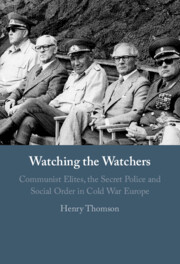Book contents
- Frontmatter
- Dedication
- Contents
- Figures
- Tables
- Acknowledgments
- Part I Introduction and Theory
- Part II Comparative Historical Analysis: Polish People’s Republic and the German Democratic Republic
- Part III Cross-national Quantitative Analysis
- Part IV Conclusion
- 9 Conclusion
- Appendix A Secret Police Agencies and Chiefs in Socialist Central and Eastern Europe, 1945–1989
- Appendix B Survival Analysis, Chapter 7
- Appendix C Agency Size Analysis, Chapter 8
- Bibliography
- Index
9 - Conclusion
from Part IV - Conclusion
Published online by Cambridge University Press: 22 February 2024
- Frontmatter
- Dedication
- Contents
- Figures
- Tables
- Acknowledgments
- Part I Introduction and Theory
- Part II Comparative Historical Analysis: Polish People’s Republic and the German Democratic Republic
- Part III Cross-national Quantitative Analysis
- Part IV Conclusion
- 9 Conclusion
- Appendix A Secret Police Agencies and Chiefs in Socialist Central and Eastern Europe, 1945–1989
- Appendix B Survival Analysis, Chapter 7
- Appendix C Agency Size Analysis, Chapter 8
- Bibliography
- Index
Summary
In this conclusion, I draw broader lessons for the study of authoritarian regimes from the analyses of this book. I call for greater attention to coercive institutions by scholars of authoritarian politics, and for authoritarian regimes to be theorized as groups rather than unitary actors. I briefly discuss the applicability of my theoretical argument to the Chinese case. Under Mao Zedong, breakdown of elite cohesion during the Cultural Revolution was associated with a decline in the capacity of the Ministry of Public Security. This mirrors reductions in coercive capacity after post-Stalinist transitions in Central and Eastern Europe.
Keywords
- Type
- Chapter
- Information
- Watching the WatchersCommunist Elites, the Secret Police and Social Order in Cold War Europe, pp. 255 - 266Publisher: Cambridge University PressPrint publication year: 2024

